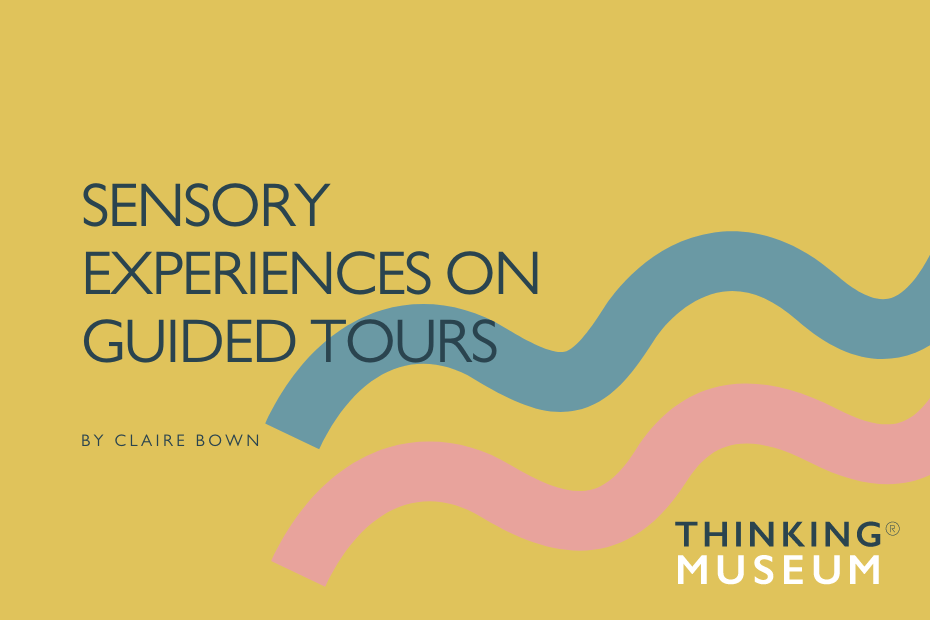On a guided tour, using an approach that appeals to all or some of the senses will help you to make your tour experiences more memorable and engaging. It will also help you to communicate your ideas more effectively. In this week’s Tips and Tools we’re looking at ways to make your tour a more sensory experience.
When we travel to a new city or enter a museum for the first time, our senses go into overdrive. We’re excited by so many new things to see, hear, smell and do.
A guided tour helps participants to focus this sensory overload by exploring certain objects, artworks or cultural sites. Using an approach that appeals to all the senses will help you to better communicate ideas and make your tours come alive. This applies to everyone, but particularly for any participants with sensory impairments.
However, I’ve lost count of the times when I’ve been on a tour and the guide is passively describing what we’re looking at when we could actually be seeing, touching, tasting, hearing, smelling instead. So, here are some easy tips and tools to make your tour a more complete sensory experience.
Tools for Sensory Experiences on Guided Tours
Supplementary Materials
- Show and pass around samples of materials used in artworks, sculptures etc, e.g. marble, aluminium or lead; fabric samples; feathers. This will allow participants to feel the materials as they are looking at artworks, sculptures or buildings. I used to pass around examples of alternatives that artists used to paint on when canvas wasn’t an option (e.g. jute, burlap, wrapping paper and even a tea-towel in Van Gogh’s case).
- Pass around pieces of fabric such as lace or pearls as pictured in a portrait.
- Share examples of materials used in paintings or sculptures e.g. gold leaf, marble
- Pass around a pair of glasses, a mirror or a piece of metal to show the impact of fingerprints on a surface.
- Offer firsthand experiences with tools or equipment that might be used (paint brushes/spindles/tools for etching etc)
- Hand out bottles of spices to smell or even taste when looking at cooking implements or recipes from different cultures.
- Share samples of ingredients that would be found in different food dishes e.g. herbs or spices
- Encourage the sense of smell by using cotton buds/wool dipped in essential oils, or by using smelling cubes. Smell can be so evocative to transport someone to a certain time and place.
- Play music or sound clips that relate to parts of your tour (using your phone or tablet)
- Use binoculars, magnifying glasses and viewfinders to encourage careful and detailed looking.
‘Do not underestimate the value of physical touching to make your point, reinforce your message, or keep excited little hands busy while they listen to your story’ (Nancy Cutler)
Tips for Sensory Experiences on Guided Tours Through Language
- Appeal to the senses by using descriptive language and words that encourage visitors to see, smell and hear:
- When you are describing something or somewhere employ the 5 senses to engage participants’ interest. Descriptive details allow sensory recreations of experiences, places or objects. You want to transport your participants into a particular scene or place in time.
- Ask your participants to describe a landscape using adjectives (use Looking Ten Times Two for an easy way to do this activity) : e.g. calm, peaceful, busy, hectic, dark, sunny, etc.
- Describe figures in a portrait: e.g. richly dressed, haughty, puzzled, relaxed, secretive, intimidating.
- Ask participants to ‘Jump In’ to any spot of their choice in an artwork and to describe what they see, smell and hear there.
- Ask questions that engage the imagination and encourage the senses.
- What sounds do you hear when you look at this artwork?
- How is this artwork like a piece of music?
- What smells do you associate with this setting?
- What might this feel like if we could touch it?
- What kind of weather do you see?
- What animal noises might you hear?
Questions that elicit careful consideration and involve the use of our five senses can result in a guided tour where people really look at, think about and engage with your content.
Although it may take a little extra effort and thought to create sensory experiences on your guided tours, it will be well rewarded by increased visitor engagement and enjoyment.
How do you create sensory experiences on your guided tours and educational programmes?
Sign up for my Curated newsletter
Every other Friday I share a small dose of curated inspiration. It might be things I’ve read, things I’ve listened to or things I’ve watched.
Hear about my latest podcast episode and read useful tips, recommendations and things that I love. Join via the button below.
